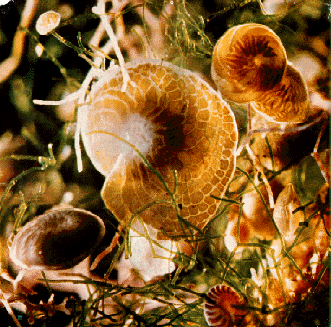A Living Specimen
 Now
that you've been inundated with pictures and descriptive analyses of foraminifera
you might wonder, so what's the point behind studying these little guys
anyway. To be brief, their global distribution and heterogeneity of visible
morphological types provide excellent paleoenvironmental indicators for
micropaleontologists. Morphological groups, ie. families and species, tend
to occur under statistically well defined conditions. From these statistical
groups one can infer what specific environment a given foraminiferal assemblage
existed in during its life mode. Environments can include defined depths,
temperatures, latitudes, chemical or energy conditions, and a variety of
other specific conditions. These have applications for paleoenvironmental
interpretation, modern sea-level fluctuation analyses so important to understanding
climate change, recent event analysis such as prehistorical earthquake
periodicity to provide new models for earthquake prediction, and many other
areas of research vital to understanding both the past, present and future
global environment.
Now
that you've been inundated with pictures and descriptive analyses of foraminifera
you might wonder, so what's the point behind studying these little guys
anyway. To be brief, their global distribution and heterogeneity of visible
morphological types provide excellent paleoenvironmental indicators for
micropaleontologists. Morphological groups, ie. families and species, tend
to occur under statistically well defined conditions. From these statistical
groups one can infer what specific environment a given foraminiferal assemblage
existed in during its life mode. Environments can include defined depths,
temperatures, latitudes, chemical or energy conditions, and a variety of
other specific conditions. These have applications for paleoenvironmental
interpretation, modern sea-level fluctuation analyses so important to understanding
climate change, recent event analysis such as prehistorical earthquake
periodicity to provide new models for earthquake prediction, and many other
areas of research vital to understanding both the past, present and future
global environment.

